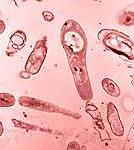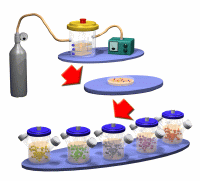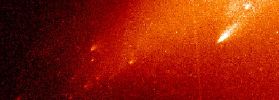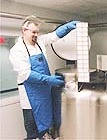 June 30: Adaptive mutation? A new article in Science reconsiders a controversial process first discussed in 1970, when molecular geneticist Miroslav Radman suggested that bacteria under stress generate genetic mutations at an increased rate. Accelerated mutation was later observed in eukaryotic cells under the stress of cancer. Even more striking, the accelerated mutations may be concentrated in specific genetic regions, a phenomenon called "directed mutation." Now two research teams have identified an enzyme, polymerase IV, that is capable of generating mutations in times of stress.
June 30: Adaptive mutation? A new article in Science reconsiders a controversial process first discussed in 1970, when molecular geneticist Miroslav Radman suggested that bacteria under stress generate genetic mutations at an increased rate. Accelerated mutation was later observed in eukaryotic cells under the stress of cancer. Even more striking, the accelerated mutations may be concentrated in specific genetic regions, a phenomenon called "directed mutation." Now two research teams have identified an enzyme, polymerase IV, that is capable of generating mutations in times of stress.
Adaptive mutation could be a way to speed up evolution when a change is needed, but many darwinists have not previously agreed that the process even occurs. How it could ever arise under strictly darwinian evolution is problematic. Now the analysis of Polymerase IV has rekindled the debate. "Most random mutations are deleterious, so how could processes that boost variability help organisms survive overall?" asks Science, paraphrasing the conservatives. We wonder why this logic doesn't mitigate against the ability of mutations to generate evolutionary progress altogether. If there is a mutation rate that leads to new traits and ever increasing fitness, darwinists, what is it?
No one doubts that point mutations can produce small adaptations (as in the color vision of coelacanths), and even larger changes by switching existing genes on or off. If adaptive mutation, concentrated in certain genetic regions, accelerates this kind of evolution when an organism is threatened, the potential survival benefit seems obvious. The problem for darwinism comes in trying to account for adaptive mutation "in the first place."
The problem for Cosmic Ancestry comes in trying to convince people that without accounting for origins "in the first place" a scientific theory of highly evolved life can be complete.
 Marina Chicurel, "Can Organisms Speed Their Own Evolution?" [summary], p 1824-1827 v 292 Science, 8 June 2001.
Marina Chicurel, "Can Organisms Speed Their Own Evolution?" [summary], p 1824-1827 v 292 Science, 8 June 2001.
 How Is It Possible? is a related CA webpage. Note especially references 13-17.
How Is It Possible? is a related CA webpage. Note especially references 13-17.
 June 26:
June 26:
Life Everywhere: The Maverick Science of Astrobiology — This new book by accomplished writer David Darling does a superb job of introducing astrobiology to the lay public. In nine chapters he covers a broad range of subtopics, including artificial life, SETI, Europa, nanobacteria, Gaia, genetics, extremophiles, ALH84001, the Viking life detection experiments, plate tectonics, and future space missions, all investigated thoroughly. The plain language and helpful metaphors make the stories clear and interesting — everyone will learn something from them. When an issue has two sides he presents both, without attempting to conceal his own preference.
Darling of course mentions panspermia, but we wish that his coverage were deeper and that he had acknowledged the strongest version of it. Instead, he recites the standard assumption, "[Life] must have had its origin at some point." But with amendments to the big bang theory, life does not need to originate. What will it take to awaken science writers to this possibility? Yet Darling's conservatism is not unusual. For an introduction to astrobiology, we recommend Life Everywhere.
 David Darling, Life Everywhere: The Maverick Science of Astrobiology, Basic Books, 2001.
David Darling, Life Everywhere: The Maverick Science of Astrobiology, Basic Books, 2001.
 June 15:
June 15:
Nutrients available to support life on Europa. Christopher Chyba of the SETI Institute (right) and Kevin Hand of Stanford University suggest that ionizing bombardment from Jupiter could create nutrients on Jupiter's moons. "Obviously, we don't know if life exists on these moons," Chyba emphasizes, "but at least we can say that if the oceans are there, the compounds that could supply energy for life seem likely to be present." An earlier report had suggested that the lack of sunlight could preclude life under Europa's ice. [Thanks, Larry Klaes and Ron Baalke.]
 Hidden Oceans Could Still Support Life [SpaceDaily version], SETI Institute, 14 June 2001.
Hidden Oceans Could Still Support Life [SpaceDaily version], SETI Institute, 14 June 2001.
 Life on Europa... has links to WhatsNEW on Jupiter's and other moons.
Life on Europa... has links to WhatsNEW on Jupiter's and other moons.
June 13:
A Mars meteorite contains water with a very low deuterium/hydrogen ratio, indicating that it came from the interior of the planet. The meteorite, recovered in the Western Saharah in December 2000, is designated NWA 817.
 Newly-found meteorite may point to water under Martian surface SpaceDaily.com, 13 June 2001.
Newly-found meteorite may point to water under Martian surface SpaceDaily.com, 13 June 2001.
 Martian meteorite may contain water by David Whitehouse, BBCNews.com, 13 June 2001.
Martian meteorite may contain water by David Whitehouse, BBCNews.com, 13 June 2001.
 Also, water near Mars' surface may have created the "rootless cones" seen in new Mars photos. From 20 to 300 meters in base diameter, they resemble cones formed on Earth's surface when flowing volcanic lava boils shallow underground water. [Thanks, CC-Net.]
Also, water near Mars' surface may have created the "rootless cones" seen in new Mars photos. From 20 to 300 meters in base diameter, they resemble cones formed on Earth's surface when flowing volcanic lava boils shallow underground water. [Thanks, CC-Net.]
 UA Scientists Find Evidence for Geologically Recent Shallow Ground Ice at Mars' Equator, by Lori Stiles, The University of Arizona, 13 June 2001.
UA Scientists Find Evidence for Geologically Recent Shallow Ground Ice at Mars' Equator, by Lori Stiles, The University of Arizona, 13 June 2001.
 If Lava Mingled with Ground Ice on Mars, by Linda M.V. Martel, Hawai'i Institute of Geophysics and Planetology, 26 June 2001.
If Lava Mingled with Ground Ice on Mars, by Linda M.V. Martel, Hawai'i Institute of Geophysics and Planetology, 26 June 2001.
 Cones on Mars, by Tom Clarke, Nature Science Update, 11 June 2001.
Cones on Mars, by Tom Clarke, Nature Science Update, 11 June 2001.
 ...Life on Mars? is the related CA webpage.
...Life on Mars? is the related CA webpage.
June 12:
Transpermia — A web article about interplanetary panspermia.
 Estimate flux of rocks bearing viable lifeforms exchanged between Earth and Mars (Transpermia) and Life's Rocky Road Between Worlds (illustrated version at SpaceDaily.com) by Michael Paine, 12 June 2001.
Estimate flux of rocks bearing viable lifeforms exchanged between Earth and Mars (Transpermia) and Life's Rocky Road Between Worlds (illustrated version at SpaceDaily.com) by Michael Paine, 12 June 2001.
 Can The Theory Be Tested? is a related CA webpage.
Can The Theory Be Tested? is a related CA webpage.
 June 8:
June 8:
DNA of revived bacteria looks modern. Therefore, say the Israeli scientists who sequenced the DNA, the bacteria revived from ancient salt crystals mined near Carlsbad, New Mexico must be contaminants. The team that originallly recovered the bacteria stands firmly by their estimated age for the bacteria of 250 million years. [Thanks, SciCentral.com.]
 Row over ancient bacteria, BBC News Online, 7 June 2001.
Row over ancient bacteria, BBC News Online, 7 June 2001.
 250 Million-year-old bacteria have been revived is the related What'sNEW item of 19 October 2000.
250 Million-year-old bacteria have been revived is the related What'sNEW item of 19 October 2000.
 June 2:
June 2:
SPIE sponsors Astrobiology IV. The conference will be held Sunday and Monday, 29-30 July 2001 in San Diego. Topics will include Biomarkers and Microfossils in Ancient Rocks and Astromaterials; Water, Ice, and Permafrost on Mars and Europa; Search for Organics and Life on Mars; Astrobiology Instruments, Methods, and Missions; Origin and Transfer of Microbial Life; NEAR Spacecraft at Eros; and Microbial Extremophiles. Richard Hoover of NASA Marshall Space Flight Center will again chair the meeting at SPIE's International Symposium on Optical Science and Technology. This time he will share duties with Gilbert V. Levin of Spherix Inc., Roland Paepe of Geobound International Ltd. (Belgium) and Alexei Y. Rozanov of Russia's Paleontological Institute. [Thanks, David McKay.]
 Instruments, Methods, and Missions for Astrobiology IV, the conference homepage at SPIE.
Instruments, Methods, and Missions for Astrobiology IV, the conference homepage at SPIE.
May 29:
Any samples returned from Mars must be quarantined. This is the conclusion of The Committee on Planetary and Lunar Exploration that is part of the National Research Council.
 The Quarantine and Certification of Martian Samples, National Academy Press, 2001.
The Quarantine and Certification of Martian Samples, National Academy Press, 2001.
 Quarantine urged for Mars sample return, by Richard Stenger, CNN.com, 29 May 2001.
Quarantine urged for Mars sample return, by Richard Stenger, CNN.com, 29 May 2001.
 Prepare Now For Martian Samples Warn Scientists, SpaceDaily.com, 29 May 2001.
Prepare Now For Martian Samples Warn Scientists, SpaceDaily.com, 29 May 2001.
 The Quarantine And Certification Of Martian Samples, by Barry E. DiGregorio, SpaceDaily.com, 31 May 2001.
The Quarantine And Certification Of Martian Samples, by Barry E. DiGregorio, SpaceDaily.com, 31 May 2001.
 Kenneth Chang, "Panel Advises Quarantine for Any Material From Mars" [text], The New York Times, 30 May 2001.
Kenneth Chang, "Panel Advises Quarantine for Any Material From Mars" [text], The New York Times, 30 May 2001.
 David Chandler, "Mars rocks seen coming before means to handle them," p A5 Boston Globe, 30 May 2001.
David Chandler, "Mars rocks seen coming before means to handle them," p A5 Boston Globe, 30 May 2001.
 Life on Mars! is the related CA webpage.
Life on Mars! is the related CA webpage.
 May 29:
May 29:
A report on the European exo/astrobiology workshop. Organic molecules in space, exoplanets, ozone as a biosignature, ESA's Darwin mission, bacterial habitats, and robotic planetary missions were hot topics at the recent meeting of about 200 scientists in Frascati, Italy. ESA's web story does not mention the recent Italian report concerning bacteria cultured from a meteorite. The next meeting will be in Graz, Austria, in September 2002.
 Life, the universe and everything discussed in Frascati, ESA, 29 May 2001.
Life, the universe and everything discussed in Frascati, ESA, 29 May 2001.
May 28:
Eukaryote-to-prokaryote evolution in 15 days?! Douglas H. Robinson, President and Chief Scientific Officer of deNovo Biologic, reports that he has isolated prokaryotes from a culture of only human eukaryotic cells deprived of oxygen —
- "I developed a sterile bioprocess using a sterile in vitro culture system in which sterile retrovirally transformed human eukaryotes were subjected to an environmental pressure of alternating aerobiosis and anaerobiosis.
- "Within 15 days ...prokaryotes with Gram-positive eubacterial features were isolated.
- "Extensive in-house and independent sterility testing ...indicated that the [eukaryotic] cells ...harbored no microorganisms prior to the oxygen-related environmental pressure.
- "Prokaryotes were isolated from no other condition." (Controls were negative.)
If this result is valid, it is remarkable for a number of reasons. In discussion Robinson observes that "a small group of evolutionary biologists has proposed recently a eukaryotic rooting for the universal tree of life," for which proposal this experiment would provide support. Of course, such a phylogeny would make the origin of life an even more difficult problem than it already is.
 The experiment is also noteworthy for its speed. It would stand in marked contrast to other closed system experiments starting with prokaryotes that have run for over ten years now. The latter have yielded many genetic mutations and phenotypic adaptations, but no new genes for new functions (and no eukaryotes!) The new experiment would reinforce our view that evolution is a robust process that goes only sideways or backward in a closed system.
The experiment is also noteworthy for its speed. It would stand in marked contrast to other closed system experiments starting with prokaryotes that have run for over ten years now. The latter have yielded many genetic mutations and phenotypic adaptations, but no new genes for new functions (and no eukaryotes!) The new experiment would reinforce our view that evolution is a robust process that goes only sideways or backward in a closed system.
One of the bacteria that evolved out of Robinson's experiment, tentatively classified as a member of the Staphylococcus epidermis group, was selected for genome sequence analysis. Using high-throughput genome sequencing (htgs), Robinson found 22 DNA kilobases related to sequences on 19 different human chromosomes. But a shotgun library sampling turned up 69 kilobases (63% of the sampled sequences) that do not match DNA sequences in any current database. More of this genome may be recognized later, as the databases grow; but most of the human geneome is already in the databases, isn't it? Robinson suggests the unfamiliar sequences "may be due to widespread retroelement-mediated recombination events." In only 15 days? Maybe evolution is even more robust than we thought.
We will watch closely for any confirmation or disconfirmation of this experiment. Informed feedback is invited!
 Douglas H. Robinson, "An Oxygen-related bioprocess drives eukaryote-to-prokaryote genome evolution and speciation" [PDF] from deNovo Biologic, 2001.
Douglas H. Robinson, "An Oxygen-related bioprocess drives eukaryote-to-prokaryote genome evolution and speciation" [PDF] from deNovo Biologic, 2001.
 Neo-Darwinism... is a related CA webpage.
Neo-Darwinism... is a related CA webpage.
 WhatsNEW 1999, July 15 describes the closed system experiments starting with prokaryotes that have run for over ten years now.
WhatsNEW 1999, July 15 describes the closed system experiments starting with prokaryotes that have run for over ten years now.
 1 June 2001 — We emailed Robinson to ask about confirmation of this experiment, and he replied, 21 June 2001.
1 June 2001 — We emailed Robinson to ask about confirmation of this experiment, and he replied, 21 June 2001.
 Were Bacteria the First Forms of Life on Earth?, by Daniel C. Jeffares and Anthony M. Poole, actionbioscience.org, Dec 2000.
Were Bacteria the First Forms of Life on Earth?, by Daniel C. Jeffares and Anthony M. Poole, actionbioscience.org, Dec 2000.
 May 21:
May 21:
Astrobiology Workshop at Macquarie University in Sydney, 12-13 July 2001. Topics will include The Origin of Life, Early History of Life on Earth, Extremophiles, Extrasolar Planets, Life on Other Planets, and The Search for Extraterrestrial Intelligence (SETI). The workshop will open with a public lecture by Paul Davies on the evening of 11 July. [Thanks, Michael Paine.]
 Astrobiology Workshop, homepage at the Anglo-Australian Observatory.
Astrobiology Workshop, homepage at the Anglo-Australian Observatory.
May 17:
Hubble Space Telescope's pictures of comet LINEAR have provided astronomers their first close-up view of the dismantling of a comet's nucleus due to warming by the Sun. These and other observations suggest that comets may well have provided Earth's seawater and the ingredients for life. "The smaller comets ...impacted Earth relatively gently, shattering high in the atmosphere and delivering most of their organic molecules intact. ...This means life on Earth did not have to start completely from scratch. Instead, it was delivered in kit form from space," says Mike Mumma of NASA's Goddard Space Flight Center. This thinking signals that mainstream science has accepted pseudo-panspermia and moved a step closer to the full theory. Seven articles in Science and many web articles announce new LINEAR observations.

 Hermann Boehnhardt, "The Death of a Comet and the Birth of Our Solar System" [summary], p 1307-1309 v 292 Science, 18 May 2001.
Hermann Boehnhardt, "The Death of a Comet and the Birth of Our Solar System" [summary], p 1307-1309 v 292 Science, 18 May 2001.
 J. Teemu T. Mkinen et al., "Water Production of Comet C/1999 S4 (LINEAR) Observed with the SWAN Instrument" [abstract], p 1326-1329 v 292 Science, 18 May 2001.
J. Teemu T. Mkinen et al., "Water Production of Comet C/1999 S4 (LINEAR) Observed with the SWAN Instrument" [abstract], p 1326-1329 v 292 Science, 18 May 2001.
 H. A. Weaver et al., "HST and VLT Investigations of the Fragments of Comet C/1999 S4 (LINEAR)" [abstract], p 1329-1333 v 292 Science, 18 May 2001.
H. A. Weaver et al., "HST and VLT Investigations of the Fragments of Comet C/1999 S4 (LINEAR)" [abstract], p 1329-1333 v 292 Science, 18 May 2001.
 M. J. Mumma et al., "Organic Composition of C/1999 S4 (LINEAR): A Comet Formed Near Jupiter?" [abstract], p 1334-1339 v 292 Science, 18 May 2001.
M. J. Mumma et al., "Organic Composition of C/1999 S4 (LINEAR): A Comet Formed Near Jupiter?" [abstract], p 1334-1339 v 292 Science, 18 May 2001.
 Dominique Bockele-Morvan et al., "Outgassing Behavior and Composition of Comet C/1999 S4 (LINEAR) During Its Disruption" [abstract], p 1339-1343 v 292 Science, 18 May 2001.
Dominique Bockele-Morvan et al., "Outgassing Behavior and Composition of Comet C/1999 S4 (LINEAR) During Its Disruption" [abstract], p 1339-1343 v 292 Science, 18 May 2001.
 C. M. Lisse et al., "Charge Exchange-Induced X-Ray Emission from Comet C/1999 S4 (LINEAR)" [abstract], p 1343-1348 v 292 Science, 18 May 2001.
C. M. Lisse et al., "Charge Exchange-Induced X-Ray Emission from Comet C/1999 S4 (LINEAR)" [abstract], p 1343-1348 v 292 Science, 18 May 2001.
 Tony L. Farnham et al., "Imaging and Photometry of Comet C/1999 S4 (LINEAR) Before Perihelion and After Breakup" [abstract], p 1348-1353 v 292 Science, 18 May 2001.
Tony L. Farnham et al., "Imaging and Photometry of Comet C/1999 S4 (LINEAR) Before Perihelion and After Breakup" [abstract], p 1348-1353 v 292 Science, 18 May 2001.
 Dying Comet's Kin May Have Nourished Life on Earth, Release No. 01-46 by William Steigerwald, NASA's Goddard Space Flight Center, 17 May 2001.
Dying Comet's Kin May Have Nourished Life on Earth, Release No. 01-46 by William Steigerwald, NASA's Goddard Space Flight Center, 17 May 2001.
 Breakup Of Comet LINEAR As Seen By SOHO Spacecraft, UniSci.com, 18 May 2001.
Breakup Of Comet LINEAR As Seen By SOHO Spacecraft, UniSci.com, 18 May 2001.
 Comet LINEAR Splits Further, European Southern Observatory, 18 May 2001.
Comet LINEAR Splits Further, European Southern Observatory, 18 May 2001.
 A Taste for Comet Water, Science@NASA, 18 May 2001.
A Taste for Comet Water, Science@NASA, 18 May 2001.
 Hubble Sees Mini-comet Fragments from Comet Linear, Space Telescope Science Institute, 7 August 2000.
Hubble Sees Mini-comet Fragments from Comet Linear, Space Telescope Science Institute, 7 August 2000.
 Comets... is a related CA webpage.
Comets... is a related CA webpage.
 May 16:
May 16:
European Workshop on Exo/Astrobiology, 21-23 May 2001. "This is the first of an intended series of workshops aimed at bringing together European scientists to review the status of the field and develop future plans and perspectives."
 First European Workshop on Exo/Astrobiology, homepage at European Space Agency.
First European Workshop on Exo/Astrobiology, homepage at European Space Agency.
 Europe launches into astrobiology, newsrelease from ESA, 23 May 2001.
Europe launches into astrobiology, newsrelease from ESA, 23 May 2001.
 May 15:
May 15:
A web article about earthly contamination of samples from space says that it is difficult to prevent. The May 10 announcement that bacteria have been cultured from a meteorite in Italy will meet strong scepticism because of this difficulty. [Thanks, Michael Paine.]
 Apollo Moon Rocks: Dirty Little Secrets, by Leonard David, Space.com, 26 March 2001.
Apollo Moon Rocks: Dirty Little Secrets, by Leonard David, Space.com, 26 March 2001.
 Bacteria..., a CA webpage, tells about streptococcus germs that survived on the moon. The new web article casts doubt there also.
Bacteria..., a CA webpage, tells about streptococcus germs that survived on the moon. The new web article casts doubt there also.
May 11:
A web article by Chandra Wickramasinghe outlines the case for panspermia and gives links to two related papers. One, co-authored by Fred Hoyle, includes a useful history of panspermia; the other presents an opposing view. [Thanks, Chandra.]
 Life from Space: An Emerging Paradigm, by Chandra Wickramasinghe, BioScience Productions, 2001.
Life from Space: An Emerging Paradigm, by Chandra Wickramasinghe, BioScience Productions, 2001.
 May 10:
May 10:
Italians culture bacteria from a meteorite. Bruno D'Argenio, a geologist working for the Italian National Research Council, and Giuseppe Geraci, professor of molecular biology at Naples University, cultured microorganisms from inside 4.5 billion-year-old meteorites kept at Naples' mineralogical museum. The researchers presented their findings at the Italian Space Agency yesterday, and at the Accademia dei Lincei (Academy of the Lynxes) in Rome, today. "Their genetic code is unlike any known on Earth," said Giovanni F. Bignami, scientific director of the Italian Space Agency. Amid the excitement we remember that old museum specimens are almost always contaminated, so the presence of culturable bacteria in meteorites is not, by itself, proof that the bacteria arrived on the meteorite. Margherita Hack, director of the Inter-University Regional Center for Astrophysics and Cosmology in Trieste, has doubts about the evidence, but she opines anyway, "It is very likely that life is spread in universe." It will be interesting to watch the story unfold. [Thanks, Calvin Shipbaugh and Jim Galasyn.]
 Italian researchers find traces of life in meteorites, Rome (AFP) 10 May 2001.
Italian researchers find traces of life in meteorites, Rome (AFP) 10 May 2001.
 Scientists Claim to Revive Alien Bacteria, by Rossella Lorenzi, Discovery News, 10 May 2001. "Italian researchers claim to have found conclusive evidence that life on Earth arrived from outer space."
Scientists Claim to Revive Alien Bacteria, by Rossella Lorenzi, Discovery News, 10 May 2001. "Italian researchers claim to have found conclusive evidence that life on Earth arrived from outer space."
 Italian Team Claims to Have Revived Meteorite Bacteria, Space.com, 11 May 2001. With comments by NASA's Everett Gibson.
Italian Team Claims to Have Revived Meteorite Bacteria, Space.com, 11 May 2001. With comments by NASA's Everett Gibson.
 Live bacteria are cultured from a meteorite, but are they just little Earthlings?, by Debora MacKenzie, New Scientist Online News, 11 May 2001.
Live bacteria are cultured from a meteorite, but are they just little Earthlings?, by Debora MacKenzie, New Scientist Online News, 11 May 2001.
 Fossilized Bacteria in Murchison and Efremovka is a related CA webpage.
Fossilized Bacteria in Murchison and Efremovka is a related CA webpage.
 A Reply from Michael Paine, 14 May, pertains to meteorite contamination.
A Reply from Michael Paine, 14 May, pertains to meteorite contamination.
 May 8:
May 8:
Museum will preserve samples of species. A new facility at the American Museum of Natural History will be capable of holding genetic and tissue samples of over half a million species in containers cooled by liquid nitrogen. "We want to make this the central repository for nonhuman comparative genomics," said Dr. Michael J. Novacek, the museum's senior vice president and provost of science. Part of the $1 million financing for the new laboratory came from NASA. "They view a collection like this as a source of information on the evolution of life on this planet, and thus a potential source for insight on the nature and evolution of life if they encounter it elsewhere."
 Kenneth Chang, "Creating a Modern Ark of Genetic Samples" [text], The New York Times, 8 May 2001.
Kenneth Chang, "Creating a Modern Ark of Genetic Samples" [text], The New York Times, 8 May 2001.
 How Is It Possible? is a related CA webpage.
How Is It Possible? is a related CA webpage.
 May 1:
May 1:
New web stories on Mars
 LPSC 2001: A Martian Odyssey, by Bruce Moomaw, SpaceDaily.com, 1 May 2001. Multi-part story about the Houston conference and water on Mars.
LPSC 2001: A Martian Odyssey, by Bruce Moomaw, SpaceDaily.com, 1 May 2001. Multi-part story about the Houston conference and water on Mars.
 Does The Famous Martian Meteorite Really Point To Life?, Space.com, 28 April 2001. Pros and cons about the magnetites in ALH84001.
Does The Famous Martian Meteorite Really Point To Life?, Space.com, 28 April 2001. Pros and cons about the magnetites in ALH84001.
 Life on Mars! is the related CA webpage.
Life on Mars! is the related CA webpage.
